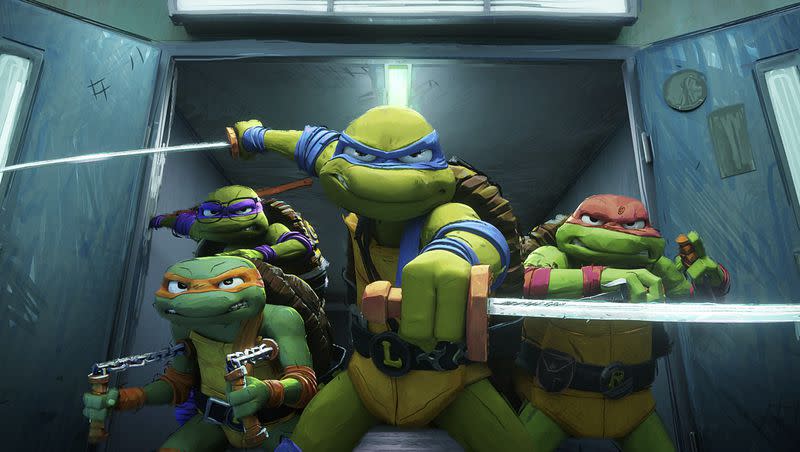Perspective: ‘Teenage Mutant Ninja Turtles’ offers the teen representation we need

- Oops!Something went wrong.Please try again later.
- Oops!Something went wrong.Please try again later.
“Teenage Mutant Ninja Turtles: Mutant Mayhem” hit theaters earlier this month and is the latest addition to what has turned out to be a very fun summer at the movies.
The film features turtle brothers Michelangelo, Leonardo, Raphael and Donatello who became mutants as infants after being exposed to mutant-ooze created by a lonely scientist trying to form his own family of mutant animals.
They are raised in a sewer by Splinter, their adoptive mutant-rat father who trains them in martial arts after being ostracized by the human world above ground. The turtles befriend April, a human teenager, who helps them uncover, and foil, another mutant’s evil plan to destroy humanity.
There is much to love about the latest version of “TMNT” from creators Seth Rogan, Jeff Rowe and Evan Goldberg. My family and I saw it the weekend the film opened, and we all had different reasons for enjoying it.
The movie is full of throwback treats for elder millennials like my husband and myself who grew up watching the original cartoon series. I knew Michelangelo as a turtle first and as an Renaissance artist second. The soundtrack features some of the greatest hits from our childhood like “No Diggity” from Blackstreet and “Can I Kick It?” from A Tribe Called Quest.
My 8- and 4-year-olds enjoyed the age-appropriate humor and thrilling action sequences. My tween, who is an aspiring illustrator, loved the animation style similar to what she’d seen in “Mitchells Vs. The Machines” and “Spider-Man: Across the Spider-Verse.”
Writer-director Jeff Rowe calls the purposefully less-than-perfect animation “a reaction to a 30-year trend in 3D CG animation to push towards photorealism and hyper-realistic lighting and texturing,” in an interview with Variety. “We decided we wanted this movie to look exactly like concept artwork, and we want the concept artwork to feel distinctly human and not computer-generated.”
“Distinctly human” is the term that best identifies what’s at the heart of “Teenage Mutant Ninja Turtles: Mutant Mayhem,” somewhat paradoxically, with four turtles and their adopted father, who is a human-sized rat, in starring roles.
Related
While the film spoke to my entire family, I believe it can speak best, like no previous version of “TMNT” has, to teens, the demographic at the center of the movie. Anyone between the ages of 12 and 18 will likely see themselves in the gangly, awkward and not yet fully formed turtles. This is a change from the cartoons of my youth.
Back then, the turtles were teens in name only. They had rippling muscles and spoke in the deep tones of the voice actors who portrayed them. This is how entertainment for children and teens has almost always been done — actors in their mid to late 30s often play 16-year-olds in teen media, and screenwriters and producers well into adulthood write scripts with dialogue unlike anything real teens actually say. Awkward female characters suddenly become beautiful women after one makeover and a dramatic removal of their glasses. Misfit young men become popular, grown males with one successful football pass.
When I became a teenager, I felt confused when I didn’t look like those 30-year-olds pretending to be in high school and instead looked (and felt) like I was stuck in a pubescent limbo between childhood and adulthood. Finding the right friends and a real sense of belonging was more complicated than my film and television consumption had led me to believe.
I would have appreciated more media representation of teens who were still growing into themselves, physically and emotionally, not teens played by actors in their late 20s saying lines written by studio executives who have no memory of how teenhood actually felt.
A recent survey published in UC Berkeley’s “Greater Good Magazine” found that most media created for teens does not feel authentic to the viewers in the demographic it targets. “Movies and television shows typically targeting American adolescents are often made without a committed consideration of their perspectives,” the authors wrote. “American teenagers now want to see Hollywood content with authentic, inclusive, and positive storytelling that better reflects their true lives and families.”
Yes, the protagonists of “Teenage Mutant Ninja Turtles: Mutant Mayhem” are cartoon turtles, but they feel authentically teen in the way they just want to be good to each other, make their dad proud and find community among their (human) peers.
The turtles are voiced by four actual teens — Micah Abbey, Shamon Brown Jr., Nicolas Cantu and Brady Noon — and are drawn as lanky with glasses and braces (there must be orthodontists and optometrists in the New York sewer systems). All they really want is to go to high school, make cool videos for social media and attend their prom without disappointing their dad. April, voiced by Ayo Adebiri, just wants to get past an embarrassing vomiting episode on the school news broadcast.
These are the concerns of real teenagers who spend their time doing homework, eating dinner with their family, and finding like-minded buddies. The authors of the Berkeley study write, “Contrary to stereotypical notions of teenage angst and self-absorption ... adolescents are leaning toward stories that provide hope and knowledge of others while also remaining fun and authentic for their age.”
Those adolescents will do well to lean toward the story told through the four teenage mutant ninja turtles.

